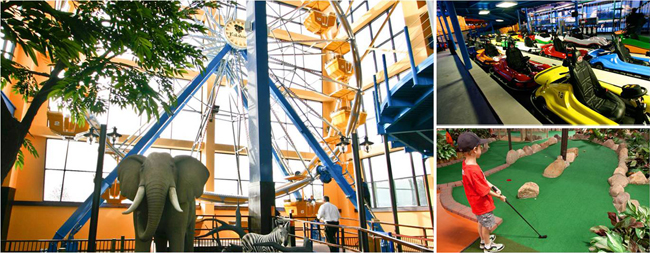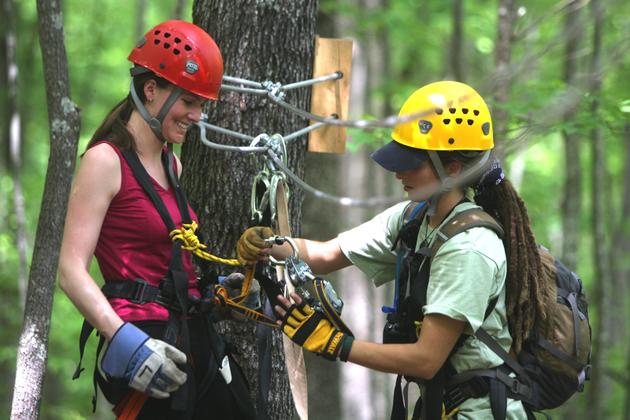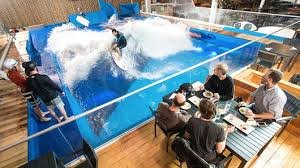
Developers Consider Options for Adding WOW
By Jeff Coy, ISHC
April, 2016. Hotels are no longer just a place to lodge and sleep. Not content with just the same old amenities, today’s hotel guest is looking for an experience.
Dad or Mom may be attending a conference at the hotel, but if the hotel also has a waterpark or a family entertainment center, there is a strong reason to bring the whole family on what would otherwise be just a business trip.
When both parents work, they already feel guilty about leaving their children home with a sitter. So hotels that offer high entertainment value and a conference center are especially appealing for Dad and Mom to mix family fun with a business trip. Like one couple said, “We came for the meeting and stayed for the entertainment.”
More Hotels & Resorts are Adding Family Play Facilities on Site?
Why are having fun facilities on site so important?
Meeting planners, for example, are looking for hotels and resorts that offer unique on-site experiences so they can avoid the hassle and cost of arranging vans to transport attendees to off-site locations for a little fun.
Years ago, hotel developers were satisfied to build a hotel near a major attraction, such as a theme park, shopping center, casino or golf course — but not anymore. Proximity matters. Often, it’s not good enough to be near an attraction. It must be on the hotel site and under hotel management to increase revenues. A hotel with a golf course two miles away does not make a golf resort. Likewise, a hotel with a family entertainment center (FEC) two blocks away does not make a family-oriented resort. To attract the leisure segment, don’t depend on the FEC down the street, build one inside your hotel.
Another reason for hotel owners to add fun facilities on site is to build a stronger magnet to attract customers.
Clustering several fun facilities together on site creates a stronger attraction. The waterpark concept was created from the combination of two previously unrelated elements — the wave pool and the waterslide. At first, both were popular as standalones, but soon their appeal and entertainment value lessened. But when the wave pool and the waterslide were combined into a single facility, the outdoor waterpark concept was born, and it took off. And when the waterpark came indoors and attached itself to hotels, the hotel waterpark resort concept was born. The idea also eliminated weather factor. No longer could poor weather wipe out hotel profits for the whole year. Bringing outdoor fun facilities indoors also eliminated seasonality. Peak season went from a 90-day period to being open 365-days a year. Quite simply, clustering several fun facilities together and eliminating the weather factor are two great ways to attract more customers.
Global Trend Toward Family-Focused Hotels
Yes. As we see more and more examples of how hotel and resort owners are adding WOW to the guest experience, it is fair to say that a new trend is developing. Our firm, as well as other research & consulting firms, track these new additions to the worldwide supply of hotels, resorts and attractions. As we collect data and analyze it, we begin to see the future emerge. A growing number of hotel and resort owners “get it” and are leading the way. As a result, more and more hotels are looking like resorts. And more and more resorts are looking like theme parks. Theme parks, outdoor waterparks and hotel indoor waterpark resorts continue to grow worldwide. And now we are seeing another major trend in resort development — adventure sports.
Emergence of Adventure Parks & Resorts

New adventure facilities are opening around the globe as both single-purpose storefronts and as part of larger, mixed use resort developments.
Not all these ventures will succeed as standalone facilities, but the probability of success increases dramatically when the resort developer adopts a few concepts:
- Bring nearby fun facilities on site
- Cluster several fun facilities into a single hotel, resort or destination
- Eliminate the weather factor
- Create a product for all seasons
- Bring outdoor activities indoors
- Add adventure
How Important are Large Asian Markets Like China?
Since the global recession, the US economy has taken 7 years to recover. Finally, the US hotel industry has surpassed its former peak, and US tourist attraction attendance is up. But during the recovery, new hotel construction stopped. Leisure travel struggled as the middle class seemed to disappear. New owners bought up low-priced hotels, resorts and attractions. During the recovery, the land of opportunity for North American hotel & entertainment companies seemed to be Asia, especially China. The leading example is Disney building Disney World Resort in Shanghai, set to open in May 2016. Other movie industry and theme park companies followed suit and opened up offices in China. China seems to have an appetite for Hollywood-type attractions. In addition, waterpark/waterslide manufacturers, such as Whitewater West of Vancouver BC, ProSlide of Ottawa ON and other North American aquatic designers started focusing on Asian markets.
Is the USA Still Leading the Way?
China and the rest of the world seem ready for hotel, resort, waterpark and theme park development. While the hotel & entertainment industries are more mature in the USA in terms of properties open and operating, US hotel & entertainment companies are focused on new development in China and the rest of the world. America continues to be the place where dreams and innovation and brand names are converted into reality. Building Disney parks, Sea Worlds, Universal Studios and Lego Discovery Centers in other parts of the world is how the US is leading the way. Other companies, such as Polin of Turkey, Center Parcs in the UK and Kidzania of Mexico, are expanding their concepts worldwide.
Can hotel waterparks and adventure parks really draw in new guests while keeping existing guests?
Yes. Hotel and resort owners really have no choice. They are in an arms race for customers. They cannot remain stagnant and survive. They must add and expand new forms of recreation and entertainment every two to three years — in order to compete. It is called entertainment value! Every hotel and resort has an entertainment value; that is, what is the length of time a guest will stay on site based on the strength of its entertainment. Longer lengths of stay mean more money spent in the hotel or resort. For example, a hotel owner might add an indoor arcade and increase guest length of stay by two hours. Another hotel owner might open a 40,000 sf indoor waterpark and increase guest length of stay by 2.5 days on site.
How do you attract new guests while keeping existing guests? There are four different types of hotel or resort guests:
- Individual leisure
- Individual business
- Group leisure
- Group business
Full service urban hotels may have a preponderance of individual business customers. Convention hotels may have a lot of group business, ie meetings. And destination resorts may have a majority of individual leisure guests. While every hotel may attract a large share of one type of customer, every hotel needs ALL four types of customers to achieve the highest potential occupancy.
Some industry observers will tell you that business suits and swim suits don’t mix. And that’s true. BUT as a hotel waterpark owner-operator, you need them BOTH to achieve maximum potential occupancy. So, how do you balance the act?
To prevent businessmen or meeting attendees from tripping over wet kids with swim suits, you just have to design your meeting facilities away from your waterpark facilities. It’s not that hard to do! Split Rock Resort in the Pocono Mountains has 650 rooms and 53,000 sf H2Ooooh indoor waterpark. The resort has 77,000 sf of meeting space, a good reason for meeting planners to invite the whole family.
Many hotel waterpark resorts have been built with little or no meeting space, and that’s a mistake, in my opinion. They run full on the weekends with families, but they run a low occupancy during the week due to a remote location, a lack of business travelers and a lack of meeting space. If you lack a business clientele, the only thing left are groups — groups such as meetings, conferences, expositions and sporting events. If you have no space for groups, you are trying to operate with one hand tied behind your back.
My favorite hotel waterpark resort owners are the ones who have successfully created a product that appeals to all different types of customers without conflicts to achieve a high-quality experience with maximum results — and that is why they are the smartest.
What Play Structures Are Most Popular with Hotels and Resorts?
Almost every hotel owner is considering doing something with water. The projects come in all sizes and shapes — ranging from enclosing the outdoor pool to raising the roof for waterslide towers and adding water play equipment to existing pools. Not all pool enhancements will compete on a resort level. Even small hotels with a simple water feature will possess a competitive advantage over hotels without a water feature.
New hotel waterpark resort developments will have a high entertainment value to attract families willing to drive 200 miles and pay more than $200 for a room. As Todd Nelson, owner of three Kalahari Resorts in Wisconsin Dells WI, Sandusky OH and the Poconos PA, says, “Bigger is better.” The first and biggest hotel indoor waterpark to enter a new market will create a high barrier to entry for other competitors to follow.
One of the most popular new waterslides is the trap door that suddenly opens and drops the rider 60 feet down a long tube that make several loops. It is like entering a phone booth with a trap door. ProSlide and Whitewater West both manufacture the ride. ProSlide calls it the Super Loop, and Whitewater calls it the Aqua Loop or Aqua Drop. The ride costs about $500,000.
Hotels with an indoor waterpark are expanding on the dry side — adding larger and more robust family entertainment centers. For example, Todd Nelson added a 30,000 sf FEC at his Kalahari Resort in the Poconos that features black light mini golf, arcade games, bowling and an XD dark ride theater. When Phase II opens in Spring 2017, the Kalahari will have 1000 rooms with the largest indoor waterpark in the USA at 200,000 square feet.
Ski resorts are adding indoor waterparks. Examples include: Mountain Grand Resort in Boyne Falls MI, Massanutten Resort in McGaheysville VA, Silver Mountain Resort in Kellogg ID, Greek Peak in Cortland NY and Jay Peak in Jay VT. Ski resorts are also adding facilities to attract guests in the spring, summer and fall seasons — facilities such as conference centers, golf courses, rock-climbing, ziplines and rope challenge courses. Smart resort owners are adopting the four season concept — something for everyone all year long.

Now resort developers are bringing the adventure indoors and closer to the customer. It seems that every natural setting has a man-made artificial version. We have indoor golf, indoor rock-climbing, indoor snow skiing, indoor skateboarding and indoor surfboarding.
Adventure sports are going mainstream. We are now seeing the emergence of Adventure Parks & Resorts. For the pure sporting enthusiast, it is often inconvenient and expensive to be in the right place at the right time — when the ocean wave is perfect or the whitewater river is cresting. While the purist may love the real thing, he or she can spend more time mastering their sport at man-made facilities, using artificial materials and simulators. For the novice, typically a teen or 20-something who wants to learn the sport, it requires a convenient facility that is close to home.
Let’s say you want to learn how to skydive.
You can look for the ideal location, near a military installation or a general aviation facility with aircraft and a sport parachute club and wait for perfect weather and availability of an aircraft and instructor to make your first jump. Or you can go to Las Vegas and float on a column of air in a vertical wind tunnel to capture the sensation of free-falling at 120 miles per hour. Or you can check into the Skyrider Inn at Eloy AZ and schedule an hour in the wind tunnel at SkyVentureArizona. Indoor skydiving is rapidly growing in the US. With more and more man-made facilities, conveniently located close to home and work, where novices and enthusiasts alike can practice their skills more frequently, adventure sports are going mainstream and becoming part of mixed-use resort developments.
What’s the Future of Resort Development?
Ten major trends point the way for more fun facilities:
- Lodging, recreation and entertainment concepts are merging
- Long weekends are replacing long vacations
- Multi-generational family gatherings are more popular
- Projects are moving toward mixed-use resort destinations
- Hotel waterpark resort growth is accelerating worldwide
- Indoor waterpark projects are getting bigger
- Adventure sports are going mainstream
- Demand is moving from natural to man-made facilities
- Every outdoor sport will have an indoor version
- New high-tech structures & enclosures can cover large spaces affordably
What Are the Options for Adding New Fun Facilities?
Consider the following adventure activities and facilities to add some WOW to your hotel or resort:
- Skating on artificial ice
- Rollerblading at indoor skate park
- Snow skiing indoors on real snow
- Snow skiing outdoors in summer on artificial surface slopes
- Water skiing without a boat using a cable system
- Surfing indoors using a wave machine
- Flowboarding using a sheet wave in a box
- Kayaking or rafting at an indoor whitewater river park
- Rock-climbing at an indoor climbing wall
- Indoor trampoline park
- Mountain biking at an indoor mountain bike park
- Rope-walking at an indoor ropes challenge course
- Ziplining at an outdoor canopy tour or indoor center
- Indoor skydiving using a vertical wind tunnel
- Golfing outdoors using a Frisbee disc
- Golfing indoor using a golf simulator
What Are the More Affordable Options That Can Help a Hotel Compete?
Choosing the right fun facility to add to your hotel or resort is a decision that involves many factors. Affordability is just one factor. Of course, you want to weigh the cost of installation and operation compared to the revenue it can generate and the payback period. Other questions to ask yourself: who is my target customer? What do they want? What does my competitor offer? What will it take to lead the competition? What is the capacity or number of people who can use this facility in a given hour? How much are they willing to pay? How much revenue can be generated? What are the annual operating expenses and cost of maintenance? How difficult and time-consuming are the repairs? Will the manufacturer stand behind the product with excellent service?
Choosing the right fun facility may establish you as the market leader.
Costs will vary from expensive to affordable. For example, a 50,000 sf indoor waterpark may cost $20 million to build, a 50,000 sf family entertainment center may cost $10 million, but an elevated go-kart track will only cost you about $650,000. A ropes course may run $300,000 and a laser tag course may be $110,000, but a golf simulator may be only $60,000. During the recent economic recovery, many resort owners found less expensive ways to add high entertainment value to their guest experience.
Resort owners with excess land may want to attract these adventure developers by offering the acres needed along with a joint venture arrangement. It’s an easier, low-cost way to bring more adventure on site and add WOW to your resort.
Potential Pitfalls When Deciding to Install New Play Facilities?
While the costs to build and operate an adventure sport are two important items to analyze, the feasibility consultant also understands that every adventure sport has an entertainment value. Entertainment value is the time that the sport will hold a user’s attention — or length of stay. Is it one hour? Four hours? One day? Two days? Does the adventure sport require overnight lodging?
For example, indoor skydiving using a vertical wind tunnel may have an entertainment value of one hour — encouraging your customer to stay on property and continue spending for one more hour. On the other hand, an indoor mountain biking park may provide 8 hours of entertainment value and encourage your customer to stay overnight in the hotel for one more night. Of course, you may need the help of an expert to choose the right adventure add-on. And you will want to compare initial costs versus the boost in resort revenue.
By mid-2016, about 350 hotel waterpark resort projects were in the development pipeline in the USA. At the same time numerous waterpark resorts and ski resorts, such as Vail, were adding Adventure Parks. This new industry is on a roll. Best advice to resort owners and developers: Get a market analysis and economic feasibility report from an independent source. It will increase your chances for success!


